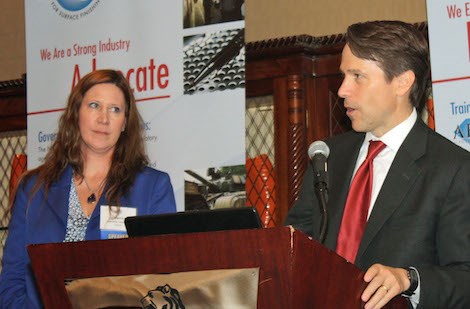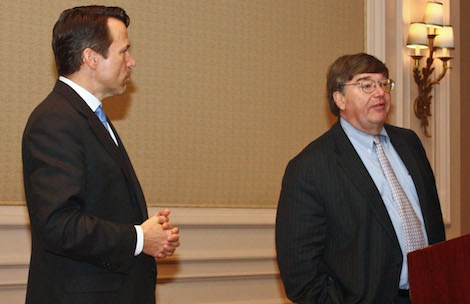NASF Washington Forum Covers Upcoming Rules, Regulations
Platers hear about new regulations, upcoming rules and visit with their Congressional representatives on Capital Hill.
#pollution control #nasf #masking
.JPG;maxWidth=600)
NASF President Rick Delawder addresses the attendees at the Washington Forum
It had been the worst winter in Washington, DC in most people’s memories (as it was for much of the country), and the surface finishers were ready for Spring and with it, the annual NASF Washington Forum, where one could get the latest information on critical legislative and regulatory matters important to the industry, and make their voices known in the halls of Congress. Rick Delawder, NASF President, in his welcoming remarks, noted that this was one of his favorite NASF venues, “although I go home with my head spinning at all the legislative and regulatory demands on our industry.” This year was no exception.
Featured Content
The global profileration of regulations persists, as more countries look into their own set of regulations, often mimicking those that have gone before. Tim Aiken, President of the Nickel Institute, cited several specific examples of substances under the gun, many of which bordered on the absurd (even stainless steel!). He did offer a hint of optimism however, as he reported that NASF/NI joint efforts had been effective in informing some regulators of the significance of the surface finishing industry. In particular, French agencies were exercising caution in the risk assessment of certain nickel salts.
One of the more insidious threats in the regulatory climate was discussed by a number of speakers. Characterized as “the tyranny of lists” was the practice of listing certain critical chemicals on lists of “substances of very high concern” or other jargon by a single agency, with very little scientific information to support the claim. Such listings could spread like a disease, prompting others to add the substance in question to their own lists, with no more justification than it being on someone else’s list. The lack of good science and common sense threatens to result in the ban of many critical chemicals to our industry and commerce in general.
.JPG;maxWidth=600)
Joelie Zak from the NASF GAC speaks.
One of the problems today is the gap between job openings and the skill set needed by the surface finishing industry. Morna Foy, of the Northcentral Technical College (Wisconsin), outlined the difficulties of motivating interest in work in the industry. NASF Stalwart John Lindstedt pointed out a critical need for lower level training courses in surface finishing, and suggested that the AESF Foundation provide this type of course.
Many of the regulations affecting the surface finishing industry stem from environmental and health concerns, both real and imagined. The positive side of this has been the efforts by some major corporations to address the problems with continued technical innovation and work with their supply chains on chemical and metals policies. Andrea Fava, of Intel, described her company’s efforts in this regard. Marty Spitzer, of the World Wildlife Fund, described similar efforts in working with companies on climate and energy goals. Auto companies in particular have been aggressive in working with their supply chain. Fortunately, knowledge that there are economies to be realized and the ever-pressing realities of climate science have encouraged many companies to work with suppliers on climate/energy goals.
Many issues that seemed settled not too long ago, are re-emerging. Just by being around for a number of years, interest in knowing whether a regulation is working well is being asked. The emergence of new technologies within the purview of a given regulation also piques the interest of regulators.
.JPG;maxWidth=600)
Macdermid's Michael Siegmund makes a comment.
Standing out is the potential revision of the Toxic Substances Control Act (TSCA), a regulatory framework that has stood the test of time for decades. Chris Bell, of Greenberg Traurig, noted that, despite its age, the act was “not toothless and was not going away.” With legislative gridlock in Washington and election year politics rendering the prospect of a revised TSCA anytime soon, the EPA was using TSCA quite effectively, making the most of existing authority and regulating new technologies (e.g., nanotechnology) quite successfully.
On the political side, a Washington Forum favorite, luncheon speaker Charlie Cook was again on hand to give his outlook for the coming midterm elections. In essence, he opined that the House would stay in Republican hands, and the Senate would be held by a narrow margin. Which party? Mr. Cook noted that the Senate was the Republican’s to lose; their control was likely, but not certain. As for 2016, he wasn’t convinced that either Hillary Clinton or Joe Biden would run. He suggested a number of scenarios for the Republican race, stressing that the party had to draw more independents and minorities to regain the White House.

Christian Richter introduces the EPA's Jennifer Lawless.
Washington Forum Regular Andy Friedman, of Washington Update was also on hand to discuss the political situation beyond electoral politics, including the federal budget, taxes and health care. Regarding the annual budget brouhaha, he noted that a compromise had been reached in Congress where there would be no shutdown or default threat thru 2015. Nonetheless, the national debt continued to grow alarmingly, raising the question of whether debt purchases by China and Japan could be sustained, and the issues that raises. He also discussed the reasons for the high degree of polarization in Washington, laying it to the considerable redistricting by largely Republican-dominated legislatures following the 2010 census. Finally, Mr. Friedman discussed the Camp Tax Reform bill. Addressing the high corporate tax rates, the bill was said to be revenue neutral, and promising.
Finally, one other area of concern was the trend toward rulemaking. With much of potential legislation in gridlock, rulemaking has been the order of the day, “putting meat on the bones of legislation,” in the words of Pat Casano, of GE. Rules by the thousands are promulgated, increasing the need for citizens and businesses to engage across many fronts.
.JPG;maxWidth=600)
Morna Foy and John Lindstedt speak about training issues.
A multitude of issues and concerns were brought to the fore at this year’s Washington Forum. On the last day, many of the attendees headed for Capitol Hill for meetings with their own legislators, giving critically needed citizen-input to issues facing the surface finishing industry. It was clear that the challenges would continue in years to come.

Christian Richter and speaker Charlie Cooke
.JPG;maxWidth=600)
NASF members gather at a reception at the Capitol.
.JPG;maxWidth=600)
Dave Marsh and Bernie Haviland talk at the Capital Visitors Center.
.JPG;maxWidth=600)
NASF members at the Capitol Vistors Center reception.
RELATED CONTENT
-
PFAS and the Surface Finishing Industry
NASF and its member companies have a long history of environmental stewardship, especially when it comes to PFAS.
-
Federal Courts Stay Implementation of OSHA COVID-19 Rules
In response to a backlash of litigation, multiple federal courts have blocked implementation of OSHA and other new vaccine mandates for general industry, the healthcare industry and federal contractors.
-
Cyanide-Free Electroplating of Cu-Sn Alloys
This paper is a peer-reviewed and edited version of a presentation delivered at NASF SUR/FIN 2012 in Las Vegas, Nev., on June 13, 2012.


















